HOS Guitars » Fixing and Modding
Fixing and Modding
My services include guitar maintenance, repair, restoration and modding.
In general, only a few of the factory made instruments are OK when they get to the hands of the client. They are still in the factory setup. They might need a quick fix or some larger modding: the neck might need to be straightened, the strings may be too high and they might rattle and the intonation is usually a bit off. An instrument should also receive regular maintenance.
The instruments that are brought in for repair have usually been at it for a long time. Their frets often need to be sanded or replace, the necks need to be straightened, the fretboards have to be sanded and the electoronics have to be fixed and the components and pickups need to be replaced.
Then there are some "larger catastrophies". A cracked soundboard, a bridge that has come loose, a broken neck can all be treated. I've seen even some totalled guitars, but so far, I've been able to fix everything.
Modding aims to give a new life or spirit to the instrument. A modded instrument can be used to match and emphasize the identity of its player. We can go so far that the difference between the starting point and the modded instruments is like the difference of a night and a day. Any of the components can be changed. Painting and other alterations to the look provide a world of opportunities.
The goal of the modding can also be to achieve a better feel for the instrument and to create a better sound. The profile of the neck and the frets can be altered and the pickups can be changed.
When it comes to restoration, I'm all about patience. An instrument that has been trough the test of time should look and feel the part. These instruments have a soul that should not be taken away. I try to repair the instruments with the techniques and the feel of the period. All new parts are wheathered so they won't clash with the overall look. I've received some pieces for repair even from abroad.
Blasts from the past
Gibson L3 from 1919
This grand ole guitar was a pleasant supprise. It has certainly had an eventful life and it was still in a decent shape. Its sound had become course and muted. I had been given two weeks to get this guitar back to shape before it was going to be used for recording.
Some intensive care was needed. The soundboard was split so I injected glue in it and put pressure on it. A light touch of shellac and color. I fixed the frets and touched up the saddle. One should take care not to overrepair a gem like this one. Many an instrument has been ruined with i.e. a new coat of lacquer. In the end, I had some time to break in the guitar to find its the original sound.
The old timer sang beautifully. All ready for a new record.
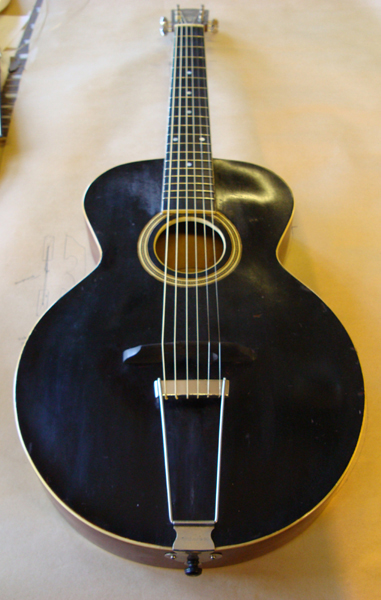 |
 |
 |
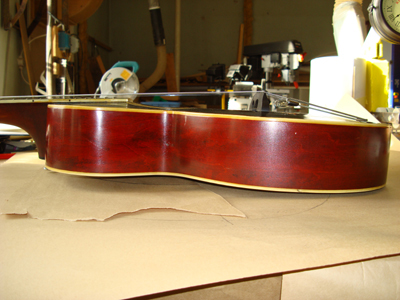 |
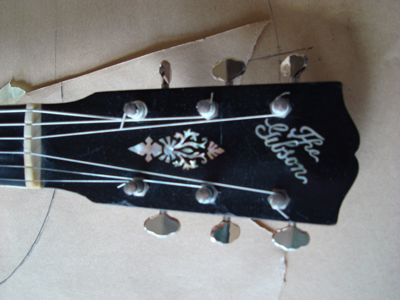 |
Ibanez “Randy Scruggs” Professional model 2671
This one made me gasp. It was an extremely rare collectors item. In 1976, only a handful of Professional model guitars were made. The instrument that wound up in my shop was the number 18 of the series.
The instrument belonged to the late, great Petteri Salminen and had been lost for ages. Thanks to the persistence of my client, the guitar was found and will soon see the light of the day again. This is the instrument that Petteri played when he recorded an unbelievably beautiful solo using a 50 öre coin. The song in question was Syksyn Sävel by Juice Leskinen.
I needed another breather after inspecting the guitar. What a waste, I thought. Had it been used to dig a ditch, to chop wood or what. At some point the neck had been glued with epoxy together with various spare wood. As you might guess, all the measurements were off and the neck pointed to a completely wrong cardinal direction. Separating the neck and building a new neck pocket took some time. But easy does it....
How this instrument ended up in Finland shall remain a mystery.
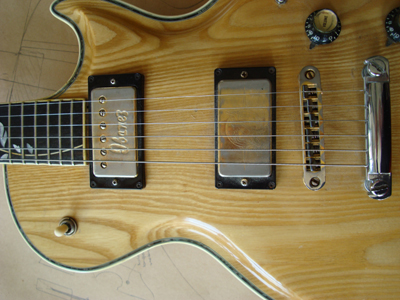 |
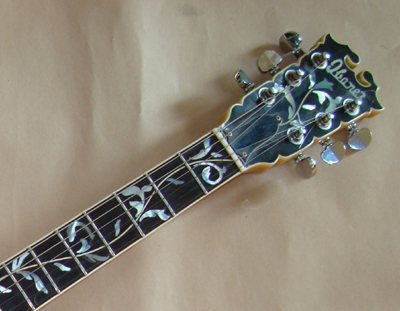 |
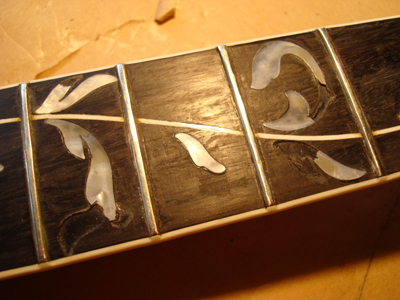 |
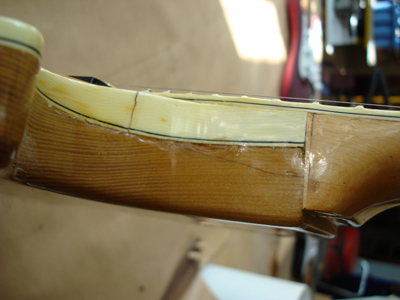 |
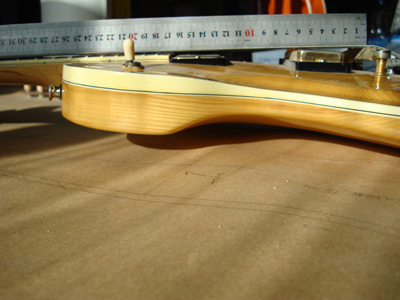 |
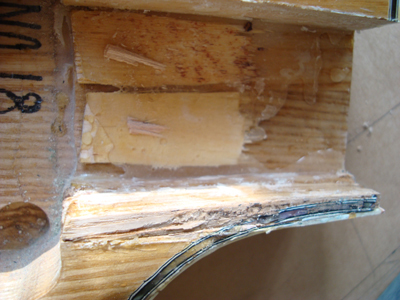 |
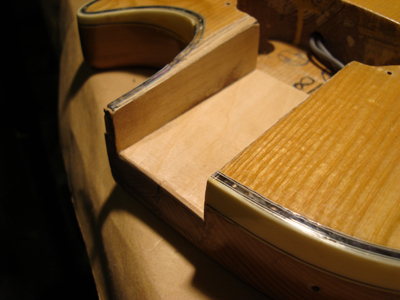 |
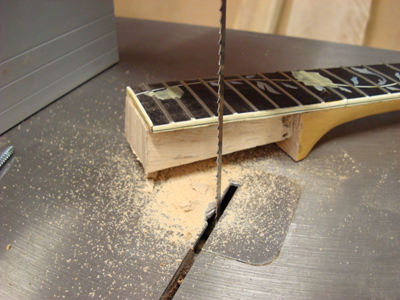 |
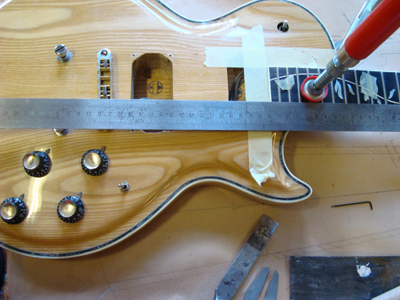 |
Accidents happen
A bit of a slip and the headstock was severed from the neck. In the aftermath, the pickups got a run for their money too. Time to give a thorough health inspection for this instrument. A few tricks to patch up the headstock: a glue injection and into the jig for pressure. The fixed part was sanded, painted and covered with lacquer. Fretwork. The saddle to its place. Clean-up and polish. The pickups were replaced with a Seymour Duncan 59 Vintage Blues set. And how it sang! The Les Paul has generated a lot of interest in the Torbjörns Studio.
 |
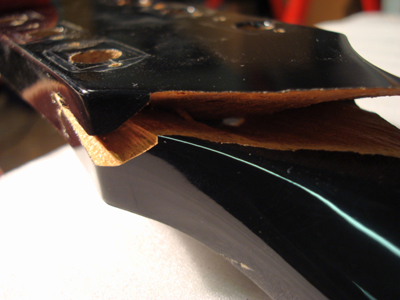 |
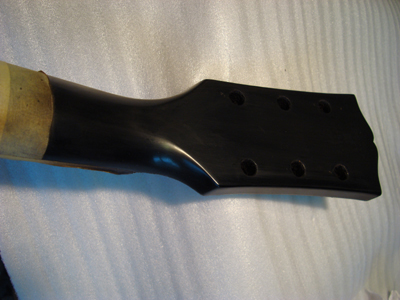 |
 |
 |
Time for maintenance
Here's an example of an instrument that was brought in for maintenance. Sanding the frets wasn't enough this time. The frets were worn out and we decided to replace them. When replacing the frets I always plane the fretboard to achieve a straight and clean base for the fretwork. The frets are profiled to create a good touch. The bridge and the saddle are checked out while I'm at it.
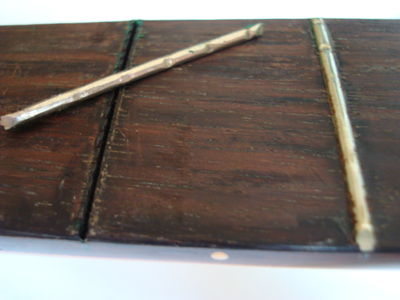 |
 |
 |

